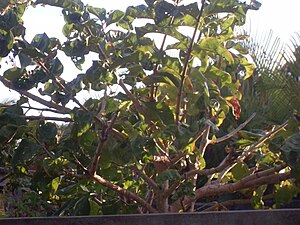Vangueria madagascariensis
| Vangueria madagascariensis | ||||||||||||
|---|---|---|---|---|---|---|---|---|---|---|---|---|

Vangueria madagascariensis |
||||||||||||
| Systematics | ||||||||||||
|
||||||||||||
| Scientific name | ||||||||||||
| Vangueria madagascariensis | ||||||||||||
| JFGmel. |
Vangueria madagascariensis is a species of the red family. English common names are Spanish Tamarind or Voavanga . The smaller Vangueria infausta is used in a similar way.
description
Vangueria madagascariensis grows as a deciduous shrub or small tree to a height of about 10-15 meters. The trunk diameter reaches 20-30 centimeters
The simple, short-stalked, thin, slightly leathery leaves are opposite and bare. The short petiole is up to about 1.3 inches long. The leaves are entire, pointed to pointed and ovate to elliptical. They are 12.5–23 inches long and 6.5–11.5 inches wide. The falling stipules are fused.
Small and axillary panicles , cymes are formed. The greenish, small, about 6-7 millimeters large and hermaphrodite, short-stalked flowers with a double bloom are five-fold. There is a very small, somewhat hairy flower cup . The outside somewhat hairy calyx is small and five-lobed. The crown is fused in a cup-shaped manner, with a corolla tube with hair on the throat, with sweeping tips. The short stamens sit at the top of the corolla tube. The ovary is inferior with a long, slightly protruding stylus and large, capitate, conical scar .
The yellow to orange then red, overripe brown and rounded, mehrsamigen, smooth stone fruits with stable, pointed calyx remains at the top are about 3-4.5 centimeters. They contain up to 5 red-brown, flattened and egg-shaped to elliptical, slightly wrinkled stone cores. The pulp is brownish.
distribution
It occurs from South , East to Central to West Africa and in Sudan and Madagascar . The species is also cultivated in some other countries, e.g. B. in the Caribbean , Hawaii , Australia or China and India .
Systematics
One can distinguish between two varieties:
- Vangueria madagascariensis var. Abyssinica (A.Rich.) Puff : It occurs from Eritrea to northern Ethiopia.
- Vangueria madagascariensis var. Madagascariensis : It occurs in tropical and southern Africa and in Madagascar.
use
The aromatic, slightly acidic fruits are edible. They have to be consumed overripe. The bark and roots are used medicinally.
The wood can be used for some applications.
literature
- Elbert L. Little, Roy O. Woodbury, Frank H. Wadsworth: Trees of Puerto Rico and the Virgin Islands. Agriculture Handbokk 449, USDA Forest Service, 1974, pp. 912 f, 978 f.
Individual evidence
- ↑ a b c Rafaël Govaerts (Ed.): Vangueria madagascariensis. In: World Checklist of Selected Plant Families (WCSP) - The Board of Trustees of the Royal Botanic Gardens, Kew . Retrieved June 2, 2020.
Web links
- Vangueria madagascariensis at Useful Tropical Plants.